Vriesea platynema
Click thumbnails for full size, scaled to a new window.
Vriesea platynema var. platynema
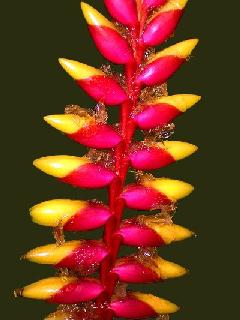
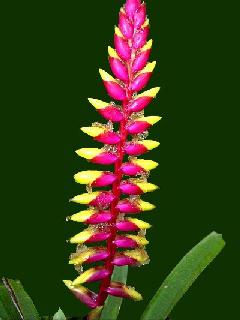
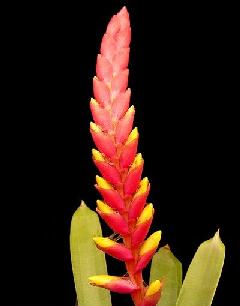
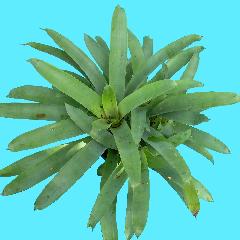
| Michael Romanowski. |
Allan Ladd. |
VRIESEA PLATYNEMA by Derek Butcher in Bromeletter 36 (4): 7-8. 1998
How many of you are growing this plant?
Recently Peter Franklin of Raymond Terrace, New South Wales, sent me a photograph of Vriesea platynema var. variegata and I asked him what he had done with the longitudinal yellow striations on the leaves. Mind you, the leaves were reddish-purple underneath and they had a red tip as per the description in Reitz's book `Bromeliaceas', although the floral bracts were not totally red. Anyway, Peter pondered.
Later on Peter conceded that he was considering dropping the `variegata' part. He must have been looking a bit more closely at his plants because he asked whether I had got my V. platynema var. rosea from Olive Trevor because he thought it was closer to the variety flava. I thought, `Damn, he's caught me out again'. Yes, the floral bracts on my V. platynema var. rosea were predominantly yellow, and yes, the leaves had rounded ends with a short tip and not a long tapering tip. Investigation was needed.
Smith & Downs (Flora Neotropica Tillandsioideae, 1997, pages 1124-1129) refers to 8 varieties of Vriesea platynema, although there are now only 7 with var. gracilior being a species in its own right.
Our V. platynema var. rosea doesn't fit where it should because it doesn't have acuminate leaf blades and it doesn't have red floral bracts. I have assumed it should have red bracts because I can't find anything to the contrary. The leaves are supposed to be concolorous and the plant was originally called Vriesea rosea. Perhaps there is a full description in PhytoIcon 27, 1884 but the plant was only known from cultivation. Smith reports no further sightings in the wild and it seems doubtful that this would have survived in cultivation for such a long time. The same thoughts apply to the variety libonii. The description for V. platynema var. flava says scape bracts and floral bracts totally yellow which are the only stumbling blocks because leaf colour and shape seem to match. In fact, the red tips to scape bracts and the floral bracts suggest it is halfway between V. platynema var. platynema and V. platynema var. flava.
In separating the varieties, Smith uses a somewhat vague term ‘leaf blades essentially concolourous‘, which I found difficult to understand until I started to check the underneath of the leaves of my plant. Some leaves did have some reddish colouring especially towards the sheath but most leaves did not. This inconsistency was a puzzle.
Taxonomists will never take an interest in our plant because we don't have collection data but you never know, a similar plant may be found in the wild and given a new varietal name. In the meantime, I'm changing my label to V. aff platynema var. flava. If you want to be extra careful perhaps just V. platynema but not V. platynema var. rosea.
To possibly ‘add chaos to confusion', did you know that there is a plant doing the rounds as Vriesea fosteriana x fenestralis with flowers identical to our alleged V. platynema var. rosea? What I find interesting is that both V. fosteriana and to a lesser extent V. fenestralis have spotted floral bracts and yet the supposed hybrid has none. Perhaps, when your V. fosteriana x fenestralis flowers, you may like to check for spots or check it against the V. platynema var. flava description.
What's going to happen to Peter's V. platynema var. variegata? Well, he tells me it was grown from seed and does not appear to be offsetting! Problem solved? Well, it may be but we must remember that only rarely do we get variegation transmitted via seed and to my mind the plant should have been called `discolor' in the first place to save argument. Perhaps we'll allow Peter to keep var. variegata as a herbarium specimen. May it R.I.P.
Meanwhile, please keep a look out for a V. platynema which has totally red floral bracts and let me know when you find one.
Addendum. In 2003 when in Melbourne it was a great surprise to find a true V. platynema var. platynema in flower in the collection of Mick Romanowski. See photos above.
The following plants are "as labelled".
Vriesea platynema var. flava
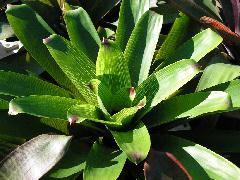
| Richard Harper, labelled "flava". |
Vriesea platynema var. Variegata
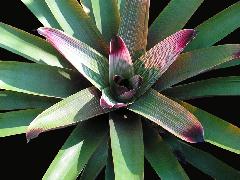
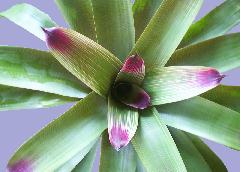
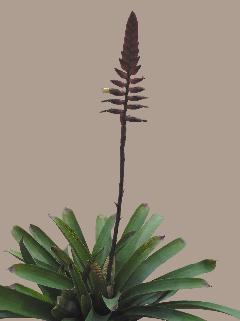
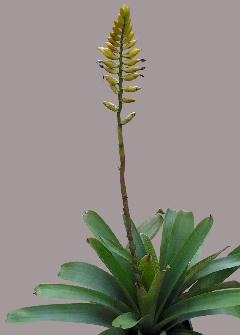
| Richard Harper. |
Ian Hook, Sydney 04/06. |
Ken Woods, Red spike. |
Ken Woods, Yellow spike. |
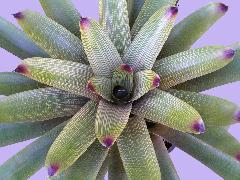
| Photo Ken Woods, plant Daryl Ganters. |
Updated 20/06/09








